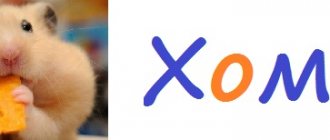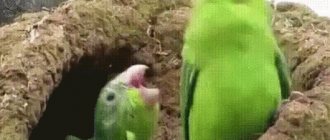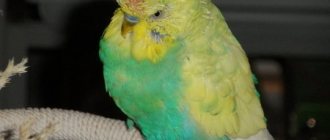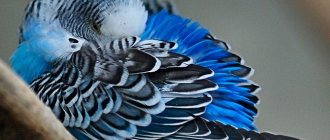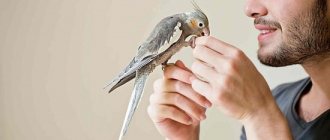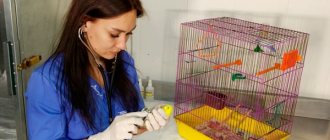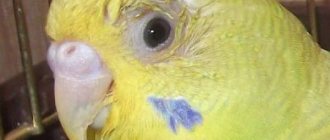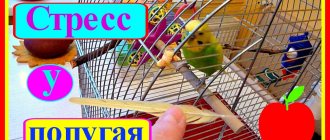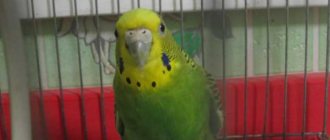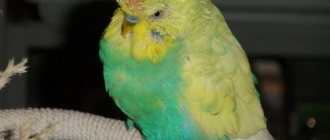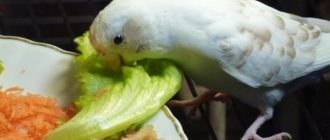A healthy bird, accustomed to a new environment, flies, chirps, preens itself, plays, and sleeps.
A parrot in the house is always interesting.
And although there are many oddities in the behavior of a parrot (especially if you just got yourself a bird), you as the owner may be alarmed by the fact that the bird opens its beak wide, as if it wants to scream or yawn, but no sounds are heard.
What could this behavior mean?
Does it say that the bird is in danger?
- Why does a parrot open its beak?
- Natural behavior of parrots
- Food does not go down the throat
- Tracheal mite infestation
- Parrot breathes with open beak
- Respiratory poisoning
- Attempts to speak
Why does a parrot open its beak?
A parrot can open its mouth for various reasons. Fortunately, in most cases, fears turn out to be unfounded, and such abnormal behavior for the human eye turns out to be natural for birds.
Important! Poor nutrition can lead to this behavior. Lack of vitamins and minerals increases the likelihood of changes in beak structure. It becomes soft, the bird stops living fully, grabbing food, and cleaning its feathers. The general condition of the parrot worsens, the deformation of the beak causes discomfort when breathing, and the bird’s mouth, most often, remains open.
For a deeper understanding, let's break down the reasons why a parrot opens its mouth and stretches its neck into several main types: natural causes, diseases, attempts to talk.
Disorders caused by deficiency or excess of vitamin K
Vitamin K, or phylloquinone, is involved in the liver's production of prothrombin, thereby influencing the rate of blood clotting.
Vitamin K deficiency usually occurs with long-term treatment of poultry with antibiotics, as well as with the regular addition of charcoal preparations to the feed and in some other cases.
With a lack of phylloquinone, the parrot weakens, almost does not react to external stimuli, and loses appetite.
The bird's blood clotting is impaired and there is a tendency to bleed.
popugauka.ru
Natural behavior of parrots
Very often, natural behavior for a bird can frighten owners. Please note the following factors.
The parrot opens its beak and stretches its neck:
- Widely open beak - the parrot yawns or asks its cage neighbor to feed itself.
- Rhythmically opens its mouth, as if trying to breathe - the bird is stressed or thirsty.
- The feathered pet may be disturbed, frightened or disturbed by something. He simply does not like the environment and environment in which he lives.
- When a parrot is hot, it sticks out its wings and often opens its beak, and may also move its tongue. It is important to provide general access to the drinking bowl and ventilate the room where the cage is located.
- Parrots (and cockatoos, cockatiels and budgies) are very clean birds and can devote a lot of time to caring for their feathers, several hours a day, especially during the molting period. After the bird cleans its wings, the fluff often gets into its throat, which makes breathing difficult and brings a lot of discomfort. The pet tries to get rid of this inconvenience and remove the fluff from there, for which it has to open its mouth wide and stretch its neck.
For such reasons, there is no need to worry too much about your feathered pet.
Pneumonia
One of the most serious causes of heavy breathing can be pneumonia caused by a fungal or bacterial infection. Other symptoms of this disease include sneezing, wheezing, coughing with a whistling or squeaking sound, and tail wagging in time with breathing. The disease is very difficult to treat and is often complicated by pulmonary edema, which leads to death.
Treatment is carried out only after consultation with an ornithologist and its effectiveness depends on how soon after identifying the first symptoms you contact a specialist. In case of pneumonia, it is important that the bird does not starve. Force feeding of liquid food from a syringe through the beak will be required. More than five hours of fasting leads to the inevitable death of the bird.
Tracheal mite infestation
This parasite is very dangerous for parrots and can lead to the death of the bird.
Symptoms may be pronounced or not appear at all.
Infection occurs in the following way:
- upon contact with another infected bird;
- as a result of accidental ingestion of tick eggs;
- upon contact with a contaminated surface;
- when consuming low-quality food and water.
The first symptom is loss of voice or change in voice.
Problems with the respiratory system quickly appear, starting: sneezing, coughing, frequent swallowing of saliva, difficulty breathing quickly.
Moreover, the bird spends most of its time with its beak open.
Sometimes this condition is accompanied by a characteristic click of the beak and a whistle.
In advanced cases, loss of plumage is observed, mainly on the head.
The bird will not get any better; it needs to be shown to a veterinarian immediately at the first signs, as the condition will continue to worsen.
The feathered friend will begin to regurgitate food or refuse it completely and throw back its head.
The parrot opens its mouth due to difficulty breathing, death can occur as a result of suffocation.
To prevent this situation, you need to disinfect cages and accessories and fulfill a number of other requirements for caring for poultry.
Main symptoms of diseases
If we compare the metabolism of a parrot and a human, then in a bird it goes much faster. This is due to the fact that only a few days will pass from the onset of the disease to the death of the pet. It is very important to know exactly what symptoms indicate a disease process and, upon noticing them, immediately seek help.
Unusual litter
Parrots consume large amounts of food per day and therefore must defecate frequently. This should not affect the bird’s well-being or the cleanliness of its feathers. The development of the pathological process is indicated by frequent or rare bowel movements, as well as sticking of droppings to the surrounding feathers.
The parrot is sick
The color of stool can indicate various disease processes. Liquid green excrement indicates liver pathology or that the bird is not eating anything. A hunger strike for parrots for even one day can be fatal. White color indicates disturbances in the enzyme system. With liver pathology or parasitic infestations, the droppings may be yellow, and with internal bleeding - black. If your pet is dehydrated, the contents of its intestines will stick to the feathers.
Ruffled Feathers
If the parrot's coat is in a state of dishevelment for a long time, this may indicate that the bird has a cold. In cases where slight trembling and heavy breathing are added to this, it means that the body temperature has increased. Birds also disguise weight loss by ruffling their plumage. A pet may have the same reaction to poisoning or an infestation of internal parasites. If the situation continues for more than a day, then you need to contact a veterinarian.
There are also conditions that do not involve a pathological process. The parrot may be afraid of something, simply freezing, or there is not enough light for it (short daylight hours in winter).
Kesha is breathing loudly! What to do???
Redness, inflammation, or discharge from the wax
The cere is the area above the parrot's beak, responsible for the respiratory process, where the nostrils are located. She needs to be monitored closely. In a healthy state, this part of the body has a uniform color without spots or peeling. Its surface is smooth, and its temperature coincides with the rest of the body. Any changes in this area: redness, swelling, discharge from the nostrils indicate an illness in the pet. If they appear, you should immediately contact an ornithologist.
The following processes most often cause changes in the cere:
- lack or excessive amounts of vitamins;
- long-term stress affecting the bird;
- pathological changes in renal tissue;
- colds and infectious diseases;
- pathogenic processes in the intestines;
- inflammatory reactions of the reproductive organs;
- water and food are of poor quality.
The parrot breathes heavily and opens its beak
Cloudy eyes
If the respiratory or nervous system is unhealthy, you can see a change in the parrot's gaze. The eyes lose their shine and become dull. The surrounding tissues turn red. The feathers around them become wet due to secreted tears. A purulent discharge appears, complicated by the addition of pathogenic microorganisms. If this condition is started, then purulent inflammation will quickly spread to the respiratory system and can cause the death of the parrot. If only one eye is affected, then the main factor is injury.
Parrot breathes with open beak
Veterinarians advise not to ignore situations when a bird is breathing with its mouth open.
This factor may be one of the most indicative symptoms of pathological processes in the respiratory tract of birds kept at home.
Respiratory diseases can pose a serious threat to the health and life of parrots.
The most dangerous disease is pneumonia.
The clinical picture is accompanied by the following behavior:
- breathing with an open mouth;
- severe cough;
- wheezing and sneezing.
Due to aspergillosis, caused by pathogenic bacteria that accumulate in the bird's lungs, the pathological condition can only be confirmed after an x-ray.
In addition to the fact that the parrot opens its mouth, it is common to cough up blood and have a fever.
A feathered pet can be cured if the disease is detected at the earliest stage.
Causes of diseases
Diseases in parrots can develop as a result of exposure to various irritants. Many of them are caused by humans.
Improper feeding and care
A poorly balanced diet can lead to various diseases. But even a well-designed menu sometimes becomes unusable. When a bird is sick, its body requires more protein or other substances.
Here are several options for feeding disorders that lead to poor health of the pet.
The parrot often opens/closes its beak
- Food enters the bird's body in insufficient quantities. This is due to the low frequency of feeding or the transfer of chicks to solid food ahead of schedule.
- An incorrectly selected diet or the appearance of foods that are unfamiliar to the bird.
- Pathological processes occurring in the digestive system, which causes loss of appetite or insufficient absorption of nutrients.
Poor hygiene
The parrot must be kept in a dry and clean place. It is necessary not only to regularly clean the cage, but also to provide bathing for the bird itself. Violation of hygiene requirements not only causes inflammatory diseases, but also creates conditions for the development of various parasites.
Drafts
Even if the air temperature is high in the room where the bird lives, drafts are very harmful. They provoke hypothermia and the development of colds in the parrot. If during ventilation it is not possible to protect your pet from drafts, then you should cover the cage with a warm cloth.
Corella parrot opens its beak - what does this mean?
Cold and damp room
For birds, it is not just humidity or temperature that is important, but their relationship with each other. So in a cold and damp room the bird will almost certainly get sick, because it will be too cold. In winter, due to heating devices, the apartments are warm, but very dry, which also affects the health of the pet.
Overheating under the sun
Prolonged exposure to the sun on a hot day, on a window in an apartment or in a car, can cause heatstroke and severe brain damage in a bird. This pathology is acute and requires immediate assistance. You should move the bird to the shade and apply a cool compress to its head and back.
Respiratory poisoning
Also, the reason parrots often open the key can be the presence of toxic substances in the air, for example, cigarette smoke, kerosene from a heater, or detergents.
The parrot begins to feel sick, and there is a clear lack of air. Treatment of the consequences is usually difficult.
Often a bird dies if veterinary care is not provided in time.
Disorders caused by deficiency or excess of vitamin D
In young birds, normal bone development is possible only if there is sufficient vitamin D, or calciferol, in the body, which is responsible for calcium-phosphorus metabolism. In addition, vitamin D prevents the development of rickets in chicks and bone decalcification in adult birds.
The consequences of a lack of calciferol can be dysfunction of the musculoskeletal system, curvature of the limbs, spinal column and sternum, thickening of the joints, as well as growth retardation.
Excess vitamin D can cause tissue calcification in a parrot.
Attempts to speak
We'll end on a good note. Another reason for the opening of the beak in parrots may be attempts to reproduce sounds.
If you often talk to your bird and set aside at least some time to teach your parrot to speak, then sooner or later the pet will answer you.
And opening the beak can be the first stage in learning words.
Carefully monitor the health of your parrot, and he will delight you for many years.
As they say in The Little Prince, we are responsible for those we have tamed.
If you know any other reasons why a parrot opens its beak, write in the comments!
With this you will help many people who are faced with the same problem with their pets.
How can you help your parrot at home?
Often, trembling that is not accompanied by other dangerous symptoms can be easily eliminated. The pet needs to be warmed and calmed.
Stress management
Moving is a common cause of mental discomfort for a parrot. Changing his cage is no less stressful for him. At the same time, the pet will begin to get nervous, cackle, and tremble. The owner may not immediately determine the cause of this condition. To calm the bird, you need to talk to it quietly and affectionately. You can stroke and caress your pet if it is tame. The old drinking bowl, feeder, and perches are installed in the new cage. You need to move your favorite toy to a new place. This way, moving to a new house can be made less traumatic.
First aid for illnesses and hypothermia
In case of dislocations and fractures, the bird is immobilized. The bottom of the cage is covered with straw. The damaged limb is bandaged, and the pet is warmed with a lamp or blanket.
An open wound must be treated with a gentle antiseptic. Hydrogen peroxide is suitable for rinsing. The cage also needs to be wrapped. Warmth will help the bird get rid of chills.
For colds and hypothermia, the bird is warmed up and given a warm infusion of chamomile (1 tbsp per 1 cup of boiling water). A regular tabletop lighting device is installed next to the cage. The lamp for it is chosen with a power of 40–60 W, no more. The light should be directed at the cell at all times until the signs of hypothermia disappear. The lighting device cannot be placed at a distance of less than 20 cm from the cage. The air temperature in the bird house should warm up to + 30 C°. One half of the cage should be covered with a blanket to create shade. As soon as the bird becomes uncomfortable or hot, it can always hide in such a shelter. Warming is carried out while the feathered pet is awake. Do not leave the lighting fixture overnight. The lamp exposure time should not exceed 4 hours.
As soon as the parrot stops cresting and hiding its head, the lighting can be turned off
It is important to prevent heat stroke
In winter, heaters are installed in the room. It is good to humidify the air periodically.
Softening
Another trouble that can happen to a parrot is a softening of the beak. This occurs when there is a lack of calcium and B vitamins. In addition, the stratum corneum softens under the influence of fungi or due to infections - viral, bacterial. Tissues become brittle and mobile. The bird protects its beak and cannot peck grain or care for its feathers. This condition is dangerous due to the presence of microcracks into which food gets, decomposes and serves as a source of infection.
Hypovitaminosis is corrected with the help of veterinary drugs: Gamavit, Beaphar (Beafar), Vinka (Vinka). If the defect appears due to an infectious disease, diagnosis and treatment are carried out by a veterinarian.
Delamination
The beak is a protein structure; Minerals participate in its formation: calcium, zinc, phosphorus. With their deficiency and vitamin deficiency, first of all, the beak changes in appearance. It delaminates and becomes covered with small cracks. Beginners in poultry farming and those who feed their pets only grain often encounter separation.
You can fix the problem by revising your diet. The bird should be given a vitamin complex and sprouted wheat. Don't forget about sepia - a source of minerals. For prevention, eggshell powder, feed yeast, and a little honey are suitable.
Knemidocoptosis
If the beak turns black or grows back, this is not the worst thing that can happen to a parrot. It is much worse if the bird becomes infected with parasites. These microscopic mites of the genus Knemidocoptes infect non-feathered areas of the body: paws, wax, area around the eyes. Pests live in the epidermis and feed on skin flakes. Their movements and waste products cause severe itching. Ticks are not visible during normal examination, but their presence is indicated by the following symptoms:
- the bird itches intensely and pecks its paws;
- growths appear on the wax;
- crusts accumulate around the eyes;
- plaque on the beak.
Vintage basket
Here we are dealing with a representative design in the style of modern rural fashion. Best suited for lovers of cycling or short distance travel on scooters. The basket itself is woven from flexible willow and equipped with an openwork wire lid, which prevents the cat from wanting to get out while moving. At the first glance at such a carrier, one is reminded of idyllic pictures from centuries ago, when food from the market was transported in a similar way on bicycles. The entire structure is conveniently attached to the steering wheel using leather straps and does not require much time for preparation.
The advantage of the option under consideration is, of course, its original design and originality. The downside is limited functionality. Although, if desired, the basket can be used for its intended purpose.
Price – 1,128 – 1,708 rubles.
